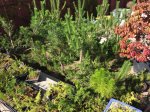May I suggest an alternative method for fattening the trunk?
The things that contribute most to pine trunk thickening are really healthy roots, and a single terminal apex.
Let's start at the bottom, the roots. They like an open well draining soil. This allows them to grow uninhibited, and quickly. A medium like pumice and lava is wonderful! Pine roots love it.
Building the trunk: a single terminal tip. The growing tips each produce a chemical called auxin. Auxin is the signal that tells the roots there's growth happening, so get busy and send nutrients up! The tree sends the nutrients up towards the strongest auxin source.
Here's an analogy: if there is only one auxin source up top, the tree focuses all its energy there. It builds a superhighway (the trunk) between that apex tip and the roots. If, on the other hand, there are lots and lots of auxin sources the energy gets spent all over! The tree builds a bit of a highway, the trunk, but then has to build saw lot of off ramps. Then secondary highways, then two lane roads, and subdivision streets, then maybe even dirt roads...
You see where I'm getting.
What we need is a place somewhere in the middle where we have a single sacrifice auxin generator, and keeping a few branches that we will develop later once the trunk is built.
Unfortunately, the Mugos sold at Lowe's and Home Depot have been grown in the exact opposite way! The remove any fast growing trunk and shear them back to the "dirt roads"!
You see, Mugo naturally tends to be more like a bush than other pines. So, the commercial growers take advantage of that and prune them like a bush.
For bonsai, we want them to be like a tree, not a bush. So, you have to find the single trunk line you want, and start to remove the "secondary roads" that compete with it. You can't remove them all at once, you have to give the tree a chance to adjust.
So at each whorl, remove one or two heavy secondary branches. It might take a couple years to remove all the excess secondaries. Keep any tiny "dirt road" branches that may be at the whorls! Those may very well be your long term keeper branches!
Let's revisit the soil... The soil they use at the nursery is cheap, and it holds water. It's not the best medium for growing roots. The best way to build a good root system would be to get rid of that soil and replace it with the pumice and lava mix. Pines generally don't like to be completely bare rooted, so do a "half bare root" to get rid of the nursery soil on one side if the rootball. A couple years later, do the other side.
I plant it in a raised bed of lava and pumice, or in a large grow Box.
Here are some JBP growing in raised beds;


